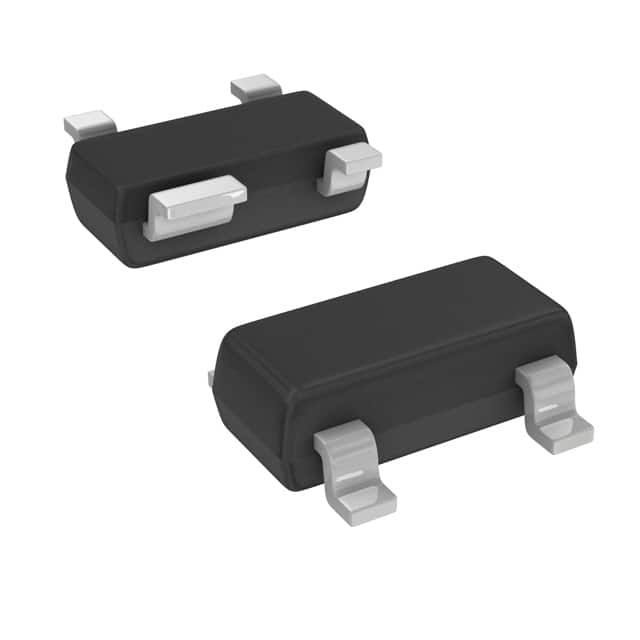HSMS-2829-TR1G
Introduction
The HSMS-2829-TR1G is a high-frequency surface mount Schottky diode designed for use in various electronic applications. This entry provides an overview of the product, including its basic information, specifications, detailed pin configuration, functional features, advantages and disadvantages, working principles, detailed application field plans, and alternative models.
Basic Information Overview
- Category: Electronic Components
- Use: The HSMS-2829-TR1G is commonly used in RF and microwave applications, including mixers, detectors, and frequency multipliers.
- Characteristics: This diode offers low barrier height and low series resistance, making it suitable for high-frequency operations. It also exhibits low junction capacitance and fast switching speeds.
- Package: The HSMS-2829-TR1G is available in a surface mount SOT-23 package.
- Essence: Its essence lies in providing reliable and efficient signal processing in high-frequency electronic circuits.
- Packaging/Quantity: The diode is typically supplied in reels or tubes, with quantities varying based on manufacturer specifications.
Specifications
- Forward Voltage: Typically 0.35V at 1mA
- Reverse Voltage: 15V
- Maximum DC Current: 20mA
- Capacitance: 0.6pF at 0V, 1MHz
- Operating Temperature Range: -65°C to +150°C
Detailed Pin Configuration
The HSMS-2829-TR1G features three pins: Anode, Cathode, and No Connection (NC). The pinout configuration is as follows: - Anode (A) - Pin 1 - Cathode (K) - Pin 2 - No Connection (NC) - Pin 3
Functional Features
- High-Frequency Operation: The diode is optimized for use in high-frequency circuits, offering fast response times and low parasitic effects.
- Low Barrier Height: This feature enables efficient signal rectification and detection in RF and microwave systems.
- Low Junction Capacitance: The low capacitance ensures minimal signal distortion and improved high-frequency performance.
Advantages and Disadvantages
Advantages
- High-speed switching capabilities
- Low forward voltage
- Compact surface mount package
- Suitable for high-frequency applications
Disadvantages
- Limited reverse voltage tolerance
- Sensitivity to overvoltage conditions
Working Principles
The HSMS-2829-TR1G operates based on the principles of Schottky diode behavior, utilizing the metal-semiconductor junction to facilitate fast switching and low forward voltage drop. When forward-biased, the diode allows current flow with minimal voltage loss, making it ideal for high-frequency signal processing.
Detailed Application Field Plans
The HSMS-2829-TR1G finds extensive use in the following application fields: - RF Mixers - RF Detectors - Frequency Multipliers - High-Frequency Signal Processing Circuits
Detailed and Complete Alternative Models
- HSMS-2829-BLKG
- HSMS-2829-TR2G
- HSMS-2829-TR2
In conclusion, the HSMS-2829-TR1G serves as a crucial component in high-frequency electronic systems, offering fast switching speeds, low forward voltage, and compact packaging. While it has limitations in reverse voltage tolerance, its advantages make it a preferred choice for RF and microwave applications.
Word Count: 443
तकनीकी समाधानों में HSMS-2829-TR1G के अनुप्रयोग से संबंधित 10 सामान्य प्रश्नों और उत्तरों की सूची बनाएं
What is HSMS-2829-TR1G?
- HSMS-2829-TR1G is a high-speed, low-power, surface-mount, red multi-level laser diode for optical storage applications.
What are the key features of HSMS-2829-TR1G?
- The key features include high speed, low power consumption, surface-mount design, and suitability for optical storage applications.
How can HSMS-2829-TR1G be integrated into technical solutions?
- HSMS-2829-TR1G can be integrated into technical solutions by incorporating it into optical storage devices such as CD/DVD drives or other data storage systems.
What are the typical operating parameters for HSMS-2829-TR1G?
- The typical operating parameters include specific voltage and current requirements, temperature ranges, and modulation characteristics.
Are there any specific application notes or guidelines for using HSMS-2829-TR1G in technical solutions?
- Yes, application notes and guidelines are available from the manufacturer to assist with the proper integration and use of HSMS-2829-TR1G in technical solutions.
What are the potential benefits of using HSMS-2829-TR1G in technical solutions?
- Potential benefits include improved data transfer speeds, lower power consumption, and compatibility with existing optical storage technologies.
Are there any known limitations or challenges when using HSMS-2829-TR1G in technical solutions?
- Some limitations may include specific environmental conditions, compatibility with other components, and potential performance trade-offs.
Can HSMS-2829-TR1G be used in conjunction with other optical components or devices?
- Yes, HSMS-2829-TR1G can be used in conjunction with other optical components and devices to create more complex technical solutions.
What are the recommended testing and validation procedures for HSMS-2829-TR1G in technical solutions?
- Recommended testing and validation procedures may include electrical testing, optical performance evaluation, and reliability testing under various operating conditions.
Where can I find additional resources or support for integrating HSMS-2829-TR1G into technical solutions?
- Additional resources and support can be obtained from the manufacturer, including datasheets, application examples, and technical support contacts.


